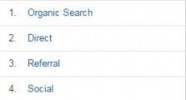
If you’re not involved in digital marketing, you might assume every visit to your website is exactly that – just a visit. But understanding how different users arrive at your website – and how their interactions with the website differ – can provide significant, actionable insight into your marketing strategy.
The truth is: People visit websites for all sorts of reasons, and they usually get to those websites in a ton of different ways. Let’s explore a few of them.
Social Traffic
Pretend you’re on Facebook, and you see a post from a friend with a link to a great bike they want to buy. An avid biker yourself, you click the link and are taken to GreatBikeCompany.com. In GreatBikeCompany’s Analytics data, your visit will show up as “Social,” since you came from a popular social network.
Organic Search Traffic
Now pretend that your Facebook friend simply mentioned the bike, but didn’t actually include a link. Still interested in learning more, you search “Great Bike Company” on Google. You find their site and click through to their home page. Now your visit is considered “Organic Search” because you arrived at the site through a search engine (or ‘naturally’ from a search).
Referral Traffic
Finally, pretend your friend never posted anything on Facebook. You’re still a bicycle enthusiast, so you naturally spend time reading about biking. At some point, you see a post on your favorite bicycle blog about GreatBikeCompany, which includes a link. Curious, you click it and are taken to GreatBikeCompany.com. This time, you’re visit is classified as “Referral Traffic.” The bike blog “referred” you to GreatBikeCompany.
Direct Traffic
Since buying a bike is a big decision for most people, you don’t instantly make a purchase. A few weeks later, after pricing some options and saving up some money, you’re finally ready to treat yourself. You’ve settled on GreatBikeCompany’s product, so you type their website address into your browser’s navigation bar, and are once again taken to their home page. This time, you’re considered a “Direct” visit. You knew the exact URL you wanted, so you went directly there, rather than going through a search engine or a link on another site.
Paid Search Traffic
Maybe you haven’t officially decided on a bike yet, but you at least have a better idea of what you’re looking for. You do a Google search for “best bikes” in the hopes of finding the best deal. At the top of the search results, you see an ad for GreatBikeCompany. You instantly know this is the bike you’re looking for, so you click the ad and get taken to a product page for the company’s newest model. This visit is considered “Paid Search” because you found the site through a paid search campaign.
Who Cares How Visitors Get to A Site?
In short: You should.
For each of these different types, you were doing completely different things, but still ended up at GreatBikeCompany.com. In some of the examples, you weren’t even aware that GreatBikeCompany existed, but for others you knew exactly what you wanted and were ready to make a purchase. This is true for everyone who visits your site – they’re all there for different reasons.
Someone may have found you through a friend’s recommendation on Facebook or Twitter, and they’re just checking out what you have to offer. Hopefully, they’ll return at some point in the future, typically through direct or organic means. Or maybe someone is already in the market for what you offer, and they happen to come across an ad of yours while searching for options.
Knowing which traffic to target for which areas of your sales funnel can not only help guide your digital marketing strategy, but also help identify opportunities for growth. We’ve explored traffic from a customer’s perspective, it’s important to learn how to interpret these different types of traffic. Our next post will discuss exactly that.




















